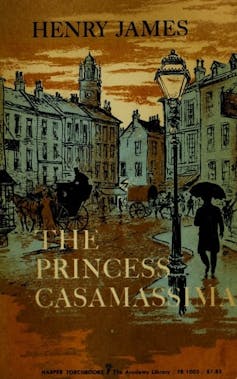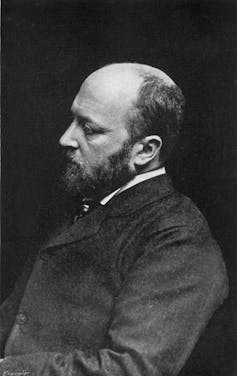The Gilded Age novel that helps explain our fascination with Luigi Mangione
Henry James’ ‘The Princess Casamassima’ tells a story of political radicalism in a time of economic inequality. But even James ran up against the limits of putting himself in the mind of a killer.

A good-looking young man with a mysterious past carries a loaded gun, ready to kill, on the streets of the world’s financial capital.
This scene not only describes Luigi Mangione’s alleged murder of United Healthcare CEO Brian Thompson in midtown New York – and the ensuing flood of media attention – but also the plot of one of Henry James’ lesser-read novels, “The Princess Casamassima.”
The high-profile slaying and James’ novel help explain the public’s fascination with political violence, and even more about the psychological guessing game that accompanies those extreme acts.
Like Mangione, the novel leaves readers wanting to know more – both Mangione and James’ stories give clues, but not the full picture, of why a person would commit such violence.
A novel of political violence
Born in the U.S. before moving to Europe, James is considered one of the most skilled writers of modern literary fiction. “The Princess Casamassima,” however, is usually overshadowed by classics such as “The Portrait of a Lady” and “The Turn of the Screw.”

Serialized in The Atlantic from 1885 to 1886, the novel tells the story of working-class and aristocratic leftists who are caught in various love triangles.
It also centers on the psychological experience of being a political radical at a time of rampant economic inequality and anarchist unrest. The late 19th century was a hotbed of political violence, with the assassination of Tsar Alexander II in 1881, the Phoenix Park murders in 1882 and the 1894 Greenwich Observatory bombing, among many other incidents, inspiring novelists on both sides of the Atlantic.
The novel’s central character, Hyacinth Robinson, grows up as a bastard orphan in working-class London. As a poor young artisan, he rages against economic inequality. But when the rich and cultured Princess Casamassima befriends him, Hyacinth becomes enamored of her lifestyle.
Meanwhile, the princess herself begins to shed the trappings of wealth as she falls in with Hyacinth’s revolutionary organization. Hyacinth, grappling with a “strange mixture of contradictory impulses,” hesitates to abandon the finer things in life: good food, French novels and high art. He vacillates between enjoying these new, beautiful experiences and fully committing himself to a ideology that would tear it all down.
Prominent liberals have been inspired by “Princess Casamassima,” as have famous Black leftists, despite its satire of radicalism.
Ralph Ellison heavily annotated his copy of the novel’s preface. James Baldwin listed the novel as one of 10 books that influenced him. And when asked which book he recommended for Black Power militants, Baldwin mentioned “Princess Casamassima.”
Never knowing the whole story
James’ plot seems modeled on the Russian novelist Ivan Turgenev’s political novel “Virgin Soil,” which also influenced Joseph Conrad’s “The Secret Agent.”
These Gilded Age novels, each of which explores political violence, struggle with the problem of getting inside the mind of a revolutionary.
Turgenev, Conrad and James found something captivating about political revolutionaries who were also well educated, cultured and sensitive. Their novels ask whether someone who finds such meaning in life and art would sacrifice themselves in pursuit of a revolution. Could protagonists follow through with acts that would destroy themselves and the things they loved?
Yet all three novelists also refuse to narrate key moments of violence from the mind of a vacillating protagonist. In “Virgin Soil,” you hear about the revolutionary action secondhand. In “The Secret Agent,” the reader never sees the bomb targeting the Greenwich Observatory explode, only the bomber’s scattered, gruesome remains.
“The Princess Casamassima” follows the same pattern. James narrates the “touching surprises” of Hyacinth’s moods and his “sudden inconsistencies of temper.” But he refrains from describing the scene – and what goes through Hyacinth’s head – when Hyacinth pledges his life to the revolution. The reader only learns about the scene later, through Hyacinth’s conversations and recollections.
Finally, after Hyacinth is called to kill – and I won’t spoil the ending – James describes the aftermath of that event, but not the act itself.
Similarly, James resists full explanations for the psychological states of secondary characters. The princess never fully says why she becomes a class traitor. She also attends revolutionary meetings outside the reach of Hyacinth and the narrator. The narrator, strangely, even describes the princess’s actions as an “immense anomaly” and “more than may be explained.”
I say “strangely” because as the creator of a fictional world, James could easily take a stab at explaining. James’ novels often offer the cause for characters’ actions with famously detailed descriptions of their thought processes. And yet, his characters will still defy explanation by behaving in unexpected ways.
The mysteries of Mangione
I think the same sense of mystery can help explain the public fascination with the Mangione case. People want to understand his motivation. While the books featured on Mangione’s Goodreads page and the posts on his social media accounts can offer clues, they don’t provide clear answers.
His relatively brief manifesto discusses the “abuse” and the “corruption and greed” of the health insurance industry. Obviously, Mangione was angry about the health care system.
But did he, or did someone close to him, experience a denied claim? Had there been a precipitating psychological break?
If what prosecutors allege is correct, why would this well-educated, successful 26-year-old, with so much life ahead of him, choose murder instead of other avenues to effect change? What went through his mind while he waited for Thompson on a midtown street? If Mangione never wavered on his hatred of health insurance companies, did he waver over resorting to deadly violence?
Part of that guessing comes from a gap in our knowledge; Mangione went off the grid in the months leading up to the alleged murder.
Even in those rare cases when the public has all the facts, it’s hard to get inside the head of someone who commits political violence. And that difficulty makes it all the more intriguing.
The limits of realism
It’s no coincidence that those who wrote about political violence struggled against the limits of the genre known as literary realism.
Novelists such as Charles Dickens, Harriet Beecher Stowe and George Eliot strove to capture the complex, interconnected systems of modern life. These literary realists used their fiction to examine the effect of circumstances on psychology. They wanted to show how someone’s upbringing and experiences influenced their choices.

Henry James’ career began during the height of the realist novel. But as scholars like Amanda Claybaugh argue, representing revolutionary violence meant “going beyond” realism. Hyacinth, the princess and other characters simply cannot be fully explained in the way realism aspires to do. Or, as scholar Michaela Bronstein writes, “Violence is the subject matter of literary forms that refuse realism.”
For the conservative James, the revolutionaries who wanted to tear down society pushed at the limits of the literary form. Psychological realism requires some sympathy with a central character. James addresses the problem by creating a revolutionary who resembles himself: not just a single-minded ideologue, but a masterful craftsman, a lover of art and a sensitive friend. Hyacinth seems to believe in the cause of equality. But as someone who also loves the world as it is, he hesitates over committing violence.
The mystery of human choices, even when circumstances are known, occupied writers like James, who seems to wonder whether he himself could actually commit political murder. He doesn’t know. And so there is a glaring gap – a mental block – when it comes to exploring his protagonist’s psyche. His realist fiction could never arrive at a full understanding.
There are many reasons why Mangione’s alleged murder of Thompson has drawn so much attention: the way it spotlights problems with the health insurance industry, the lurid details of the shooting and Mangione’s subsequent escape, and, of course, Mangione’s good looks.
Despite knowing so many details, his mental state is still a mystery.
Max Chapnick does not work for, consult, own shares in or receive funding from any company or organization that would benefit from this article, and has disclosed no relevant affiliations beyond their academic appointment.
Read These Next
The celibate, dancing Shakers were once seen as a threat to society – 250 years later, they’re part
‘The Testament of Ann Lee,’ Mona Fastvold’s 2025 film, depicts part of the long history of Shaker…
How C-reactive protein outpaced ‘bad’ cholesterol as leading heart disease risk marker
C-reactive protein – a marker of inflammation – is as easily measured with blood work in a doctor’s…
Where the wild things thrive: Finding and protecting nature’s climate change safe havens
Protecting places that are likely to remain cool and moist as global temperatures rise can save wildlife…





